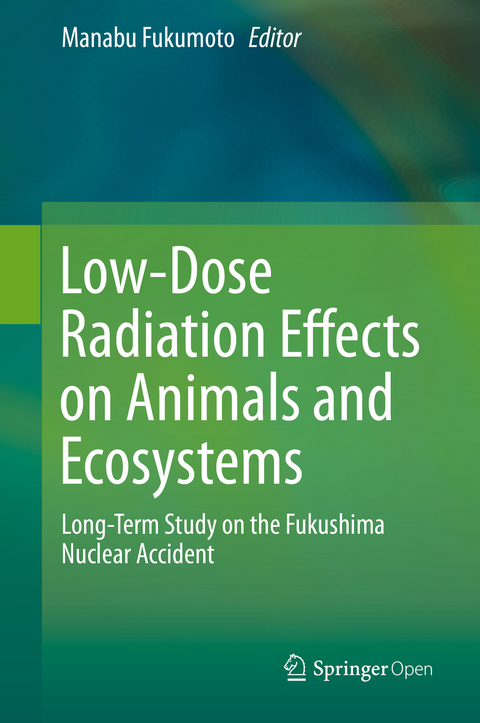
Low-Dose Radiation Effects on Animals and Ecosystems
Springer Verlag, Singapore
978-981-13-8217-8 (ISBN)
Various cases of changes in animals and organisms have been reported since the FNPP accident. However, it is often unknown whether they are actually due to radiation, since the dose or dose-rate are not necessarily associated with the changes observed. This book brings together the works of radiation biologists and ecologists to provide reliable radioecology data and gives insight into future radioprotection.
The book examines the environmental pollution and radiation exposure, and contains valuable data from abandoned livestock in the ex-evacuation zone and from wild animals including invertebrates and vertebrates, aqueous and terrestrial animals, and plants that are subjected to long-term exposure in the area still affected by radiation. It also analyzes dose evaluation, and offers new perspectives gained from the accident, as well as an overview for future studies to promote radioprotection of humans and the ecosystem.
Since the biological impact of radiation is influenced by various factors, it is difficult to scientifically define the effects of low-dose/low-dose-rate radiation. However, the detailed research data presented can be combined with the latest scientific and technological advances, such as artificial intelligence, to provide new insights in the future.
This book is a unique and valuable resource for researchers, professionals and anyone interested in the impact of exposure to radiation or contamination with radioactive materials.
Manabu Fukumoto is a pathologist, who graduated from Kyoto University, Japan. Based on autopsies of alpha-emitter Thorotrast-induced cancer cases, he has analyzed the molecular genetic carcinogenic mechanisms of internally deposited radionuclides. He has also established an archive of animals contaminated with internally deposited radionuclides from the ex-evacuation zone of the Fukushima Daiichi nuclear power plant accident and has been assessing biological effects of the accident. He served as President of the Japanese Radiation Research Society (JRRS) and a director of Japanese Pathological Society. He has received the Japanese Pathological Association Award and an Achievement Award from the JRRS for his contributions to radiation pathology.
Part 1. The Environmental Pollution Caused by the Fukushima Daiichi Nuclear Power Plant (FNPP) Accident.- 1. Estimation of Dose Rate for the Large Japanese Field Mice (Apodemus speciosus) Distributed in the “Difficult-to-Return Zones” in Fukushima Prefecture.- 2. Impacts of the Fukushima Nuclear Accident on Fishery Products and Fishing Industry.- 3. Incorporation and Accumulation of Strontium-90 in the Hard Tissue of Animals and Their Relationship with Strontium-90 Pollution in the Environment.- Part 2. Radiation Exposure and Its Effects on Wild Organisms after the FNPP Accident.- 4. Radioactive Cesium Contamination of Arthropods and Earthworms after the FNPP accident.- 5. Delayed Recovery from Declines in the Population Densities and Species Richness of Intertidal Invertebrates near the Fukushima Daiichi Nuclear Power Plant.- 6. Mutations observed in mitochondrial DNA of salmon collected in Mano River, Fukushima Prefecture, Japan.- 7. Influence of the FNPP Accident on Coniferous Trees: A Review.- Part 3. Radiation Exposure and Its Effects on Livestock after the FNPP Accident.- 8. Analysis of Ovaries and Fertilities in Domestic Animals affected by the Fukushima Daiichi Nuclear Power Plant Accident.- 9. Transgenerational Effects on Calf Spermatogenesis and Metabolome Associated with Paternal Exposure to the FNPP Accident.- 10. The Effect of Radiation on the Immune System in Pigs Affected by the Fukushima Daiichi Nuclear Power Plant Accident.- 11. Assessment of DNA Damage Induction in Farm Animals after the Fukushima Daiichi Nuclear Power Plant Accident.- Part 4. Dose Evaluation in Association with the FNPP Accident.- 12. Preliminary Study on Electron Spin Resonance Dosimetry Using Affected Cattle’s Teeth due to the Fukushima Daiichi Nuclear Power Plant Accident.- 13. Estimation of External and Internal Exposure in Japanese Macaques after the Fukushima Daiichi Nuclear Power Plant Accident.- Part 5. New Perspectives Raised after the FNPP Accident.- 14. Properties ofRadioactive Cs-bearing Particles Released by the Fukushima Daiichi Nuclear Power Plant Accident and Trace Element Analysis.- 15. Cellular Effects of Insoluble Particles Containing Radioactive Cesium.- 16. Preparation and Genome Analysis of Immortalized Cells Derived from Wild Macaques Affected by the Fukushima Daiichi Nuclear Power Plant Accident.- 17. Effects of Radioactive Cesium-containing Water on Mice.- Prt 6. Overview of the FNPP accident.- 18. Comparison of Radioactivity Release and Contamination from the Fukushima and Chernobyl Nuclear Power Plant Accidents.- 19. The Pale Grass Blue Butterfly as an Indicator for the Biological Effect of the Fukushima Daiichi Nuclear Power Plant Accident.- 20. What We Learned and are Learning from the Affected Animal Dose Assessment Project.
| Erscheinungsdatum | 29.11.2019 |
|---|---|
| Zusatzinfo | 65 Illustrations, color; 25 Illustrations, black and white; XV, 264 p. 90 illus., 65 illus. in color. |
| Verlagsort | Singapore |
| Sprache | englisch |
| Maße | 155 x 235 mm |
| Themenwelt | Medizin / Pharmazie ► Medizinische Fachgebiete ► Onkologie |
| Naturwissenschaften ► Biologie ► Genetik / Molekularbiologie | |
| Naturwissenschaften ► Biologie ► Ökologie / Naturschutz | |
| Naturwissenschaften ► Biologie ► Zoologie | |
| Naturwissenschaften ► Physik / Astronomie ► Angewandte Physik | |
| Technik | |
| Schlagworte | Chernobyl • Dose evaluation • ecosystem • FNPP • Long-term exposure to radiation • long-term sustained exposure • low dose/low dose-rate radiation • Low-dose radiation effect • Nuclear Accident • Nuclear disaster • open access • Radiation effect on animals • Radiation effect on humans • Radioactive cesium • Radioactive Contamination • radioactivity • The Fukushima Daiichi nuclear power plant accident • Thyroid gland |
| ISBN-10 | 981-13-8217-4 / 9811382174 |
| ISBN-13 | 978-981-13-8217-8 / 9789811382178 |
| Zustand | Neuware |
| Haben Sie eine Frage zum Produkt? |
aus dem Bereich


